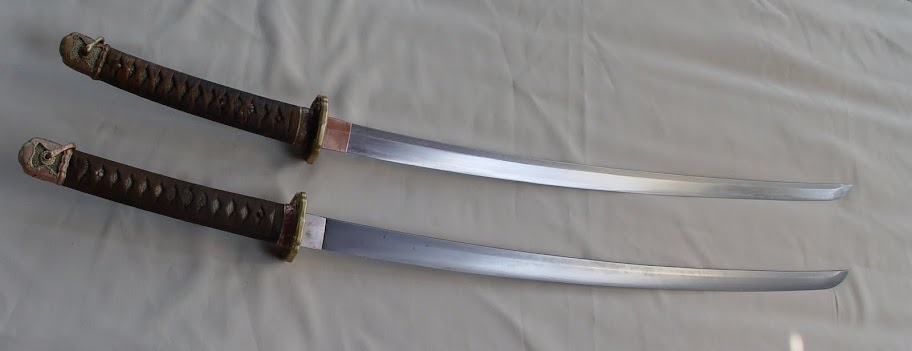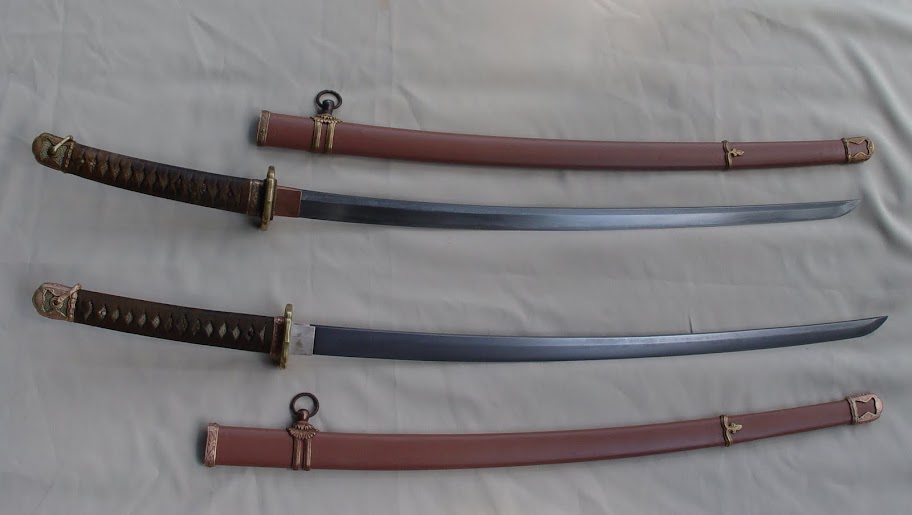Fred Rowe
Well-Known Member
But one was made by a skilled craftsman; the other, I believe, was not.
These two ww2 Japanese swords came to my shop in poor shape. I should have taken pictures, so you would not have to take my word; but both tips were bent, as if they were stabbed into concrete or the like and both blades were rusty, one more than the other.
They were both taken apart and the parts put in separate containers.
The first blade only had to have the rust lifted with naval jelly and a lot of elbow grease applied; the grinds were well done and the hamon was even and distinct; the second blade the grinds were convex instead of flat and the blade had a slight warp, the length of the blade. The hamon was high on the blade and indistinct. One of the sheaths had been used to bat rocks or something of like; the other was just rusty.
The materials were of a lesser quality in the one with the warped blade. You can tell in the photos. I really think one was manufactured in the early part of the war while the other one was produced later when the war and the money was winding down.
One point of interest, that I think worth sharing: the second sword, with the warped blade, had a paper shim inserted into the inside top of the handle [between the handle and tang] to make the handle fit correctly. I can imagine the assembler of the sword, at the time it was made; cutting the shim with his knife and inserting it between the inside top of the handle and the tang, driving it home with his palm, in order to make it fit.
The gentleman who had me clean these swords up, has always wanted a pair of Japanese swords to put on display in his home, but could never afford the older more valuable swords;
Now at 70 he now has his set of swords and it did not cost him an arm and a leg.:what!: He was pleased with the restoration; even though I admit " it was done by an amateur".
Regards, Fred
The pic at bottom shows the hamon on the top blade at a different light angle.



These two ww2 Japanese swords came to my shop in poor shape. I should have taken pictures, so you would not have to take my word; but both tips were bent, as if they were stabbed into concrete or the like and both blades were rusty, one more than the other.
They were both taken apart and the parts put in separate containers.
The first blade only had to have the rust lifted with naval jelly and a lot of elbow grease applied; the grinds were well done and the hamon was even and distinct; the second blade the grinds were convex instead of flat and the blade had a slight warp, the length of the blade. The hamon was high on the blade and indistinct. One of the sheaths had been used to bat rocks or something of like; the other was just rusty.
The materials were of a lesser quality in the one with the warped blade. You can tell in the photos. I really think one was manufactured in the early part of the war while the other one was produced later when the war and the money was winding down.
One point of interest, that I think worth sharing: the second sword, with the warped blade, had a paper shim inserted into the inside top of the handle [between the handle and tang] to make the handle fit correctly. I can imagine the assembler of the sword, at the time it was made; cutting the shim with his knife and inserting it between the inside top of the handle and the tang, driving it home with his palm, in order to make it fit.
The gentleman who had me clean these swords up, has always wanted a pair of Japanese swords to put on display in his home, but could never afford the older more valuable swords;
Now at 70 he now has his set of swords and it did not cost him an arm and a leg.:what!: He was pleased with the restoration; even though I admit " it was done by an amateur".
Regards, Fred
The pic at bottom shows the hamon on the top blade at a different light angle.
Last edited:
